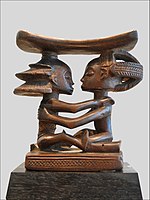Baluba
 |
|
| Total population | |
|---|---|
| (7 million) | |
| Regions with significant populations | |
| Democratic Republic of the Congo | |
| Languages | |
| Luba languages (Luba-Kasai and Luba-Katanga); French | |
| Religion | |
| Christianity, African Traditional Religion | |
| Related ethnic groups | |
| other Bantu peoples |
| Luba | |
|---|---|
| Person | Mulubà |
| People | Balubà |
| Language | Cilubà, Tshiluba, Kiluba |
| Country | Lubaland |
The Luba people, or Baluba, are one of the Bantu peoples of Central Africa, and a major ethnic group found in the south-central parts of the Democratic Republic of the Congo. They are widely distributed in this country, but are most concentrated in its Katanga, Kasai, and Maniema provinces. The Luba people consist of many sub-groups with distinct Luba language dialects, of which three are main: the Luba-Kasai, Luba-Katanga, and Swahili languages.
The Luba people founded an ancient culture by about the 5th century, and later a well organized, pre-colonial Kingdom of Luba in the Upemba Depression region of Central Africa. They had developed the knowledge and means to extracts various metals from the rich mineral resources close to them, as well as the skills in wood carving, pottery, sophisticated metal objects, ivory artwork and jewelry. Their success and wealth grew in relative isolation given their forested mountainous inland location, then attracted traders, raids and wars in second half of the 19th century. The Luba people were a victim of the slave and ivory trade, both to the Atlantic coast by Portuguese slave traders, as well as to the East African coast by Swahili-Arab slave traders particularly in the 19th-century.
Archaeological evidence suggests that the Luba people had, by the middle of 5th century AD, settled around the lakes and marshes of the Upemba Depression, in what is now the southeastern portion of the Democratic Republic of the Congo. The evidence suggesting an advanced Iron Age society by then comes from multiple sites, and these are among the best developed archaeological records in Central Africa. The Kamilambian, Kisalian and Kabambian series of evidence has been dated to be from 5th to 14th-century, suggesting a settled stable Luba culture over many centuries. Of these, the Kisalian period (8th to 11th century) pottery and utensils found, were crafted with extraordinary excellence. The finds dated to pre-8th century by modern dating methods are iron objects or pottery, thereafter copper objects appear.
...
Wikipedia
